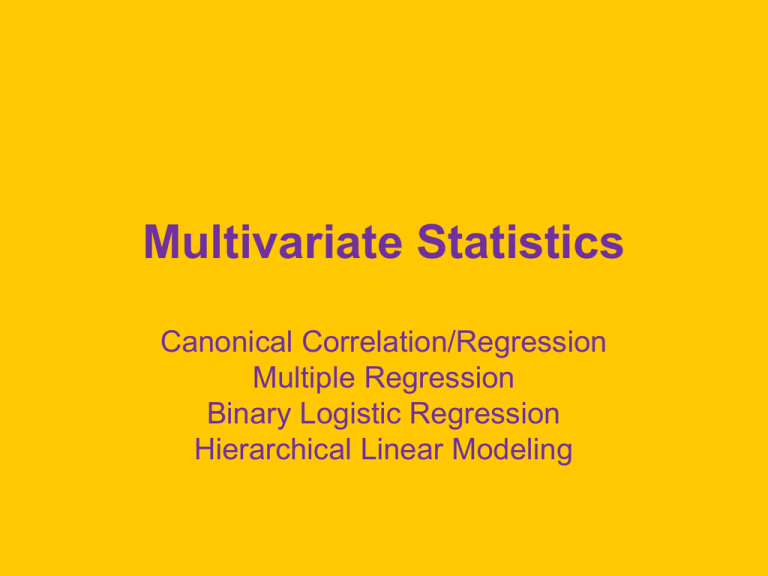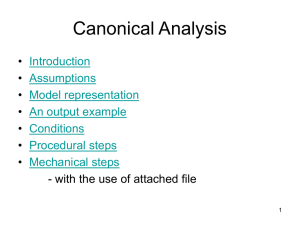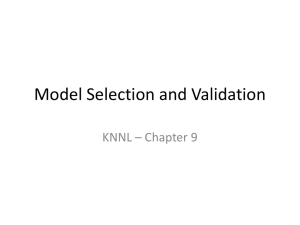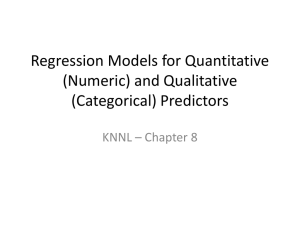
Multivariate Statistics
Canonical Correlation/Regression
Multiple Regression
Binary Logistic Regression
Hierarchical Linear Modeling
Canonical
Correlation/Regression
•
•
•
•
AKA multiple, multiple regression
AKA multivariate multiple regression
Have two sets of variables (Xs and Ys)
Create a pair of canonical variates
– a1X1 + a2X2 + .... + apXp , and
– b1Y1 + b2Y2 + .... + bmYm
• Such that the correlation between the
canonical variates is as large as possible.
Patel, Long, McCammon, &
Wuensch (1995)
• Male college students
• Xs = Personality variables (MMPI)
– PD (psychopathically deviant, Scale 4) – social
maladjustment and hostility
– MF (masculinity/femininity, Scale 5) – in men, low
scores = stereotypical masculinity
– MA (hypomania, Scale 9) – overactivity, flight of
ideas, low frustration tolerance, narcissism, irritability,
restlessness, hostility, and difficulty with controlling
impulses
– Scale K (clinical defensiveness) – low scores =
unusually frank.
Ys: Homonegativity Variables
• IAH (Index of Attitudes Towards
Homosexuals)
– Affective component of “homophobia,”
disgust.
– High scores – discomfort around
homosexuals
• SBS (self-report behavior scale)
– Past negative actions towards male
homosexuals
– High score – high frequency of such actions.
What is a Canonical Variate?
• A weighted linear combination of variables
• You can think of it as
– Something (a superordinate variable) you
have created from several variables, or
– An estimate of an construct, a latent variable,
a dimension that causes variance in the
observed variables.
What is This Thing I Have Created
or Discovered?
• Look at the standardized weights used to
construct the canonical variate.
• Even better, look at the loadings
– Compute, for each case, a score on the
canonical variate.
– Correlate those scores with scores on the
original variables in its set.
The Weights
MMPI
Femininity
-.61
Scale K
-.60
Psycho. Dev. .43
Hypomania
.46
Homoneg.
SBS
IAH
.93
.15
Being stereotypically
masculine, unusually
frank, psycho.
deviant, and
hypomanic is
associated with
acting negatively
towards gays.
The Loadings
MMPI
Scale K
-.53
Hypomania
.53
Femininity
-.49
Psycho. Dev. .32
Homoneg.
SBS
IAH
.99
.52
Being unusually
frank, hypomanic,
stereotypically
masculine, and
psycho. deviant, is
associated with
being uncomfortable
around and acting
negatively towards
gays.
Weights or Loadings?
• Like the Beta weights in a multiple
regression, the weights for a canonical
variate can be deceptive.
• If two variables within a set are well
correlated with each other, one or both
weights may be artificially low.
• I generally prefer to interpret loadings.
A Second Pair of Canonical
Variates
• There likely is variance in the variables
that was not “captured” by the first pair of
canonical variates.
• We can create a second pair, orthogonal
to the first, from that residual variance.
• The number of pairs of canonical variates
we can create is equal to the number of
variables in the smaller set.
The Second Pair of Weights
MMPI
Femininity
.70
Hypomania
.67
Psycho. Dev. -.09
Scale K
-.04
Homoneg.
IAH
SBS
-1.08
.57
Being unusually
feminine and
hypomanic is
associated with not
being uncomfortable
around gays but
acting negatively
towards them
anyhow.
The Equal Opportunity Bully
• What are we to make of “not being
uncomfortable around gays but acting
negatively towards them anyhow.”
• One student called this “the equal
opportunity bully.”
• He acts negatively towards everybody,
gay or straight.
The Second Pair of Loadings
MMPI
Femininity
.76
Hypomania
.72
Psycho. Dev. .21
Scale K
-.08
Psycho. Dev. .21
Homoneg.
IAH
-.85
SBS
.14
Being unusually
feminine and
hypomanic is
associated with not
being uncomfortable
around gays.
The Canonical Correlations
• Compute canonical variate scores for each
case.
• Correlate each with its pairmate.
• Will always be highest for first pair, lower
for each subsequent pair.
• Here, the canonical corrs are .38 and .32.
• Both were statistically significant.
Multiple Regression
• One continuous Y, two or more X
variables.
• X variables may be continuous or
dichotomous
• k groups may be represented by k-1
dichotomous dummy variables
Weight the X Variables
• Create a weighted combination of the Xs
Yˆ a b 1 X 1 b 2 X 2 b p X p
• Such that the correlation between Y and Yˆ
is as large as possible.
• That is, (Y Yˆ ) is as small as possible
• a is predicted Y when all Xs are zero
• bi is number of points Y changes for each one
point change in Xi, above and beyond the effect
of all other predictors.
2
Standardized (Beta) Weights
Zˆ Y 1 Z 1 2 Z 2 p Z p
• i is the number of standard deviations
that Yi changes for each standard
deviation change in Xi, above and beyond
the effect of all other predictors.
Sequential Analysis
• The predictors may be entered into the
model all at once (simultaneous), or
• In sets of one or more (sequential)
• Order of entry may be determined by
– Temporal relationships among predictors
– A causal model
– Economic considerations
– Other considerations
Economic Considerations
• Want to predict college GPA.
• Enter inexpensive predictors first
– High school GPA
– Verbal and quantitative SAT
– Evaluation of an essay submitted by student
– Ratings from a panel of professors who
interviewed the student on campus.
Stepwise Selection
• A statistical algorithm is used to determine
order of entry.
• The goal is to create a model that has
fewer predictors but does nearly as well as
a model with all predictors.
• Stepwise selection is among the most
misunderstood analyses known to man.
• It commonly leads to inappropriate
conclusions.
Who Will Fail College Physics?
• McCammon, S., Golden, J., & Wuensch,
K. L. (1988)
• Predict grades in physics classes from
– Critical Thinking test scores (CT)
– Thurstone’s Primary Mental Abilities Test (IQ)
– Arithmetic skills test scores (ARI)
– Algebra skills test scores (ALG)
– Math anxiety scale scores (ANX)
Simultaneous Analysis
• R is the correlation between the weighted
predictors and Y
• R = .40 and was statistically significant.
• Model explained 16% of the variance in
grades.
• Every predictor was sig. correlated with
grades (zero-order r).
• But in the model only ALG and CT had
significant unique effects.
Stepwise Analysis
• Tried both Forwards Selection and
Backwards Selection
• Both led to a model with only ALG and CT.
• We recommended that Physics use just
the ALG and CT tests to predict who is at
risk of failing.
• The motivation for using stepwise was
economic – why use 5 predictors when 2
will do as well?
Does Sex Matter?
• McCammon insisted that I address this
issue.
• Means and variances differed little
between the sexes.
• Just to please McCammon, I did the
analysis separately for men and women.
Sex Matters
• Among the men, not a single predictor was
significantly related to grades.
• Among the women, every predictor was
significantly related to grades.
• Women’s performance is class is well
related to their abilities.
• There must be some other more important
factor for predicting men’s performance.
Expert Reviewers
• Those at the physics journal to which we
submitted the manuscript rejected it.
• They argued that it was not appropriate to
publish an unexpected finding (the sex
difference).
• Such “hypothesis-induced blindness” is
not all that uncommon, unfortunately.
Political Correctness
• We submitted the manuscript to a Science
Education journal.
• One reviewer insisted that it not be
published as it is “sexist” to compare the
sexes.
• We convinced the editor otherwise.
Binary Logistic Regression
• The criterion variable is dichotomous.
• Predictor variables may be categorical or
continuous.
• If predictors are all continuous and nicely
distributed, may use discriminant function
analysis instead.
• If predictors are all categorical, may use
logit analysis instead.
Wuensch & Poteat, 1998
• Cats being used as research subjects.
• Stereotaxic surgery.
• Subjects pretend they are on university
research committee.
• Complaint filed by animal rights group.
• Vote to stop or continue the research.
Purpose of the Research
•
•
•
•
•
Cosmetic (test a hair care ingredient)
Theory Testing (neuroscience & learning)
Meat Production (feed the third world)
Veterinary (save cats from disease)
Medical (save young adults from disease)
Predictor Variables
•
•
•
•
Gender
Ethical Idealism
Ethical Relativism
Purpose of the Research
The Logit Model
• Decision 0 = stop, 1 = continue
• Gender 0 = female, 1 = male
• Model is ….. logit =
Yˆ
ln ODDS ln
1 Yˆ
a b1 X 1 b p X p
• Yˆ is the predicted probability of the event
which is coded with 1 (continue the research)
rather than with 0 (stop the research).
Decision =
Idealism, Relativism, Gender, Purpose
• Need 4 dummy variables to code the five
purposes.
• Consider the Medical group a reference
group.
• Dummy variables are: Cosmetic, Theory,
Meat, Veterin.
• 0 = not in this group, 1 = in this group.
Tests of Significance of Unique Effects
Variables in the Equation
95.0% C.I.for EXP(B)
B
Step
a
1
Wald
df
Sig.
Exp(B)
Lower
Upper
gender
1.255
20.586
1
.000
3.508
2.040
6.033
idealism
-.701
37.891
1
.000
.496
.397
.620
relatvs m
.326
6.634
1
.010
1.386
1.081
1.777
cos metic
-.709
2.850
1
.091
.492
.216
1.121
theory
-1.160
7.346
1
.007
.314
.136
.725
meat
-.866
4.164
1
.041
.421
.183
.966
veterin
-.542
1.751
1
.186
.581
.260
1.298
Constant
2.279
4.867
1
.027
9.766
a. Variable(s) entered on s tep 1: gender, idealism, relatvs m, cosmetic, theory, meat, veterin.
Exp(b) is an Odds Ratio
• For gender, b was 1.255.
Exp ( b ) e
1 . 255
3 . 508
• When gender changes from 0 (female) to
1 (male) the odds of approving the
research (1) are multiplied by 3.508
• This is above and beyond the effects of
other predictors in the model
Effect of Idealism
• For idealism, b was -0.701.
Exp ( b ) e
0 . 701
. 496
• For each one point increase in idealism, the odds
of approving the research are multiplied by .496.
• Put another way, for each one point increase in
idealism, the odds of voting to stop the research
are multiplied by 1/.496 = 2.016.
Odds Ratios for Dummy Variables
• Compares being in one group versus
being in the reference group (the one
without a dummy variable, medical in this
case).
• For theory, the odds ratio is .314.
• Odds of approving the research are 1/.314
= 3.185 times higher for the medical
research than for the theory-testing
neuroscience research.
Effects of Purpose of Research
• Odds of approving the research were
significant lower for ____ than for medical
research
– Neuroscience research
– Agricultural research
• But no significant difference for
– Cosmetic testing
– Veterinary research
Classification
• The model can be used to predict, for
each case, the probability (p) that the case
is the target event (here, approving the
research).
• You then need a decision rule: If p ≥
criterion, then predict it is (or will be) the
target event.
The Classification Decision Rule
• A criterion of .5 might seem obvious, but
that ignores the fact that false positives
and false negatives might not be equally
serious.
• You might want to use a criterion other
than .5.
Screening Test for Cancer
• Which is the more serious error
– False Positive – test says you have cancer,
but you do not
– False Negative – test says you do not have
cancer but you do
• Want to reduce the False Negative rate?
• Lower the cutoff for predicting that there is
cancer.
Classification Performance
• Overall Percentage Correct Classifications
• Sensitivity
– P(correct prediction | event did occur)
• Specificity
– P(correct prediction | event did not occur)
• False Positive Rate
– P (incorrect prediction | predicted occurrence)
• False Negative Rate
– P (incorrect prediction | predicted
nonoccurrence)
For Our Data
Value When Cutoff =
.5
.4
Sensitivity
58%
75%
Specificity
81%
72%
False Positive Rate
32%
36%
False Negative Rate
26%
19%
Overall % Correct
72%
73%
Hierarchical Linear Modeling
• You have data at two or more levels.
• Cases at each level (except the highest)
are nested within cases at the next level
up.
• For example, Level 1 is pupils.
• Level 2 is schools.
• Level 3 is school districts.
School Climate
• Rowan et al. (1991)
• Level 1 cases are teachers
• Outcome Variables at this level are ratings
of
– Principle leadership
– Teacher control of policy
– Staff cooperation
• Level 1 predictors are teacher
demographics
Level 2
• Level 2 cases are schools
• Predictors are
– Sector: school was public or Catholic
– Size of school
– Percentage minority enrollment
– Average student SES
– And other such variables.
Results
• Level 1: Ratings were related to
demographics
– For example, women thought the climate
better than did men, and
– Those teaching English, Science, and Math
thought the climate worse than did others.
• Level 2: Ratings were better in Catholic
schools than in public schools.
Noise-Induced Annoyance
• Fidell et al. (1995)
• Humans in households in three different
neighborhoods rated, on successive nights
– How annoyed they were by aircraft noise
– How long it took to fall asleep, and
– A machine measured the noise level at night.
The Design: Three Levels
• Level 1 cases were the nights (repeated
measures).
• Level 2 cases were humans.
• Level 3 cases were households.
• Ratings of annoyance was the outcome
variable.
The Predictors
• Level 1 (nights): latency to sleep and
interior noise level, and neighborhoods
were predictors.
• Level 2 (humans): age of respondent.
• Level 3 (households): neighborhood
(three groups)
Results
• There was significant variability in
annoyance among humans and among
households.
• Latency to sleep and noise level were
related to ratings of annoyance.
• The neighborhoods did not differ from
each other on annoyance.









